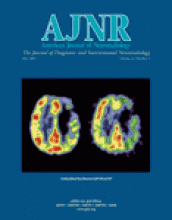Abstract
BACKGROUND AND PURPOSE: The relevance of cavernous carotid artery calcification on unenhanced CT scans of the brain has recently been investigated against the backdrop of the widespread implementation of coronary artery calcification scoring. We sought to determine whether the degree of cavernous carotid artery calcification correlated with scores of white matter hyperintensity seen on MR images. In so doing, we sought to establish a relative risk for future stroke on the grade of carotid calcification.
METHODS: Neuroradiologic findings in 187 patients who underwent CT and MR imaging examinations within 1 month of each other were retrospectively reviewed. The degree of circumferential calcification and thickness of calcification were graded for the cavernous carotid arteries on the basis of CT findings. Using the scale developed by the Cardiovascular Health Study, the white matter was graded for degree of disease on the basis of MR findings. Correlation tests and regression analyses were performed to determine the impact of age, race, and sex on results.
RESULTS: Although the cavernous carotid calcification scores and the MR imaging white matter scores showed good correlation (P < .001), the effect was mediated by age. With age factored in as a covariant, no correlation was shown between CT calcification scores and MR imaging white matter scores. Sex had no effect, but African American study participants had worse MR imaging white matter scores than did white participants.
CONCLUSION: After adjusting for age, cavernous carotid calcification grades and MR imaging white matter scores do not show a significant correlation. The relative risk for future stroke cannot be predicted from cavernous carotid calcifications.
- Copyright © American Society of Neuroradiology












